Problem Set 5
Solution Set
Chapter 6, Alkyl Halides: Substitution and Elimination
Due: Monday, October 12, 2009
xxxxxxxxxxxxxxxxx
Study #2 and #3 in the Alkyl Halide module and #1 in the Ether module
in ORGO.
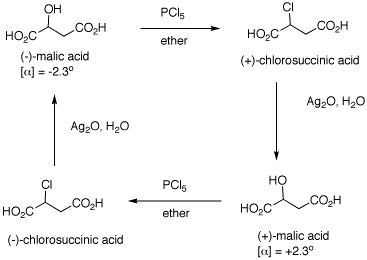
Problem Set 5
Solution Set
Chapter 6, Alkyl Halides: Substitution and Elimination
Due: Monday, October 12, 2009
xxxxxxxxxxxxxxxxx
Study #2 and #3 in the Alkyl Halide module and #1 in the Ether module
in ORGO.

1. The inversion of configuration in an
SN2 reaction is often called a Walden inversion,
named after its discoverer, Paul Walden. In the cycle shown
above, the overall conversion of one enantiomer of malic
acid to the other one must require an inversion of
configuration. Similarly, the same is true of the chloro
acids. More generally, each interconversion of enantiomers
must require an odd number of inversions. The
PCl5 reaction requires a single inversion which
means that the Ag2O reaction involves an even
number of inversions of configuration, namely two in this
instance. (-)-Malic acid is of the
(S)-configuration. a) Show how malic acid, like any alcohol,
might react with PCl5 and then undergo inversion
to form a chloride. Remember that phosphoric acid is a
strong acid and its conjugate base and analogs thereof are
also good leaving groups. b) Silver oxide is an anhydrous form of
AgOH. The carboxylic acid group closest to the hydroxyl
group plays a role in the process. The reaction medium is
mildly alkaline. Using these data, show how there is net
retention of configuration. c) Draw these four enantiomers as Fischer
projections with the CO2H closest to the OH or Cl
in the topmost position. (-)-Malic acid is of the
(S)-configuration.
a) An electron pair on
the hydroxyl group of (S)-malic acid does the equivalent of
an SN2 displacement of chloride on the phosphorus
atom of PCl5. The proton at the positive site may
be removed by chloride at this point and then chloride from
dissociated HCl can effect an SN2 displacement.
Alternatively, chloride can effect direct SN2
displacement with inversion of configuration (1st inversion)
to form (R)-chlorosuccinic acid, POCl3 and HCl.
[Note: It is also likely that the
carboxyl groups are converted to acyl chlorides during the
reaction. Aqueous workup would rapidly reform carboxyl
groups]. b) (R)-Chlorosuccinic
acid under alkaline conditions is converted to its
dicarboxylate salt. Ag+1 may or may not complex
with the chlorine atom at this point to enhance chloride as
a leaving group. AgOH is not critical. The reaction works
using NaHCO3 as a base. The proximate carboxylate
acts as a nucleophile with SN2 inversion to form
the reactive, transitory
(R)-a-lactone.
The strain of the a-lactone allows hydroxide to effect a
second SN2 displacement to form (R)-malic acid
upon acidification. This step has an even number of
inversions -- net retention. The overall process of (R)- to
(S)-malic acid has an odd number of inversions -- net
inversion.

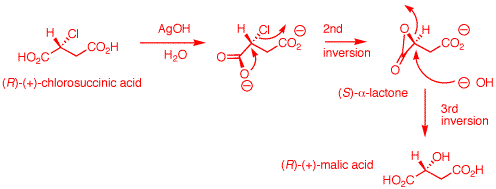
c) 2. A sample of (-)-2-iodooctane ([α]D
= -33.3o) reacts with radioactive iodide
(K131I-) in methanol until 1.5%
conversion (i. e.; 1.5% of the isolated 2-iodooctane
contains radioactive iodine.) What is the predicted rotation
of the isolated sample?
The mechanism is
SN2. At 1.5% conversion there is 98.5% of
(-)-2-iodooctane and 1.5% (+)-2-iodooctane. The optical
purity is (98.5 - 1.5)/100 = 97%. Therefore, the expected
rotation is -33.3o x 0.97 =
-32.3o. 3. A student familiar with the mechanism
of the SN2 and E2 reactions predicts that the
stereoisomer 1 may produce 2 and 3
while stereoisomer 4 will produce only 5 under
the conditions shown. Show her
reasoning.
[Note: You need to know how to draw cis-decalins.
Look here
(.ppt) or here
(.html). ] There are two
conformations of cis-decalin 1
--namely, 1a and
1b. Conformation
1a is capable of effecting an
SN2 displacement. Hydroxide reversibly
deprotonates the alcohol, which, in turn, does an
SN2 rear side displacement of chloride.
Use the Jmol structures of 1a and 1b to compare
1a and
1b. Rotate the structures to
get a good view. Click
here.
Conformation 1b has the alkoxide group remote from
the C-Cl bond. The C-Cl bond is axial and may
participate in an E2 elimination in only one
direction. There is only one axial C-H bond anti to
the C-Cl bond.

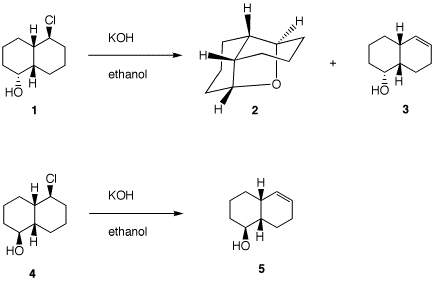
Compound 4 is a diastereomer
of 1, differing only at the
hydroxyl center. Neither conformation
4a nor 4b
can effect SN2 displacement. However, E2
elimination from conformation
4b is possible. It is likely
that during E2 elimination the alkoxides
1b and 4b
are protonated to form the alcohols.
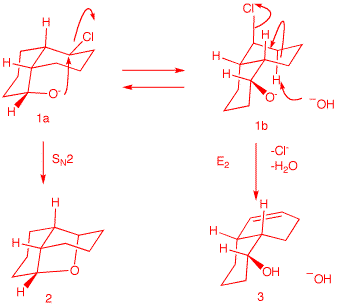
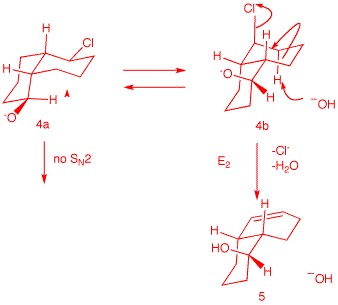
4. Provide the unknown product(s) of each reaction. In all cases,
provide mechanisms and a rationale.
|
|
|